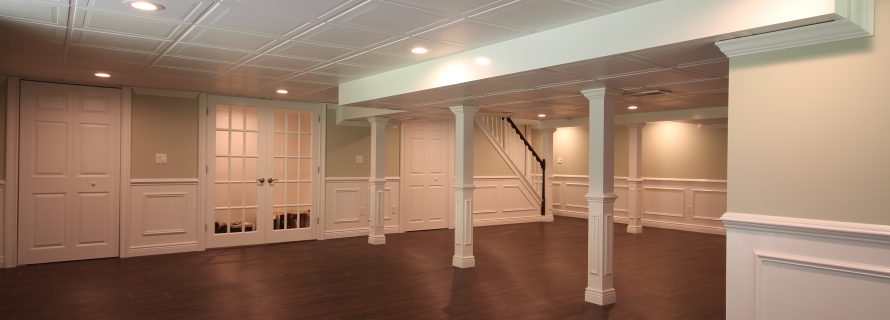Everything you need to know about converting your basement into a gym

One of the biggest challenges that comes with staying in shape is simply getting yourself to the gym. But what if you had one in your very own home? A basement is an ideal space for gym equipment, as it has strong floors that can support the weight of the equipment. Converting this area of your home into a personal workout center is a great way to avoid excuses, make your workouts more convenient and get back on top of your fitness goals. You can customize your home gym, too, according to your specific needs. Best of all, you’ll dodge expensive ongoing gym fees, saving you a substantial amount of money in the long run.
Designing your dream home gym demands some important considerations, however. Greg Griffin, Alure Home Improvements’ basement design expert, offered some insight into the planning process.
Space
First, you’ll need to determine how much space is necessary for the equipment you’re hoping to use. More specifically, it’s crucial to ensure that you have adequate head room. If you’re aiming to incorporate a treadmill or elliptical trainer, you’ll probably need at least 7 feet. On the other hand, you can get away with a lower ceiling if you’re only integrating seated machines like stationary bikes or planning to do mostly mat exercises, such as yoga or Pilates.
Comfort
Air flow is an imperative aspect to weigh to ensure that you stay comfortable throughout your sweat sessions, no matter the time of year. Ideally your basement will already have built-in windows, but what if it doesn’t? According to Griffin, it’s best to create an egress window, as he says it’s a better long-term option for safety, code and resale reasons.
If you have severe allergies or other health problems to consider, he noted that it’s critical to consider a ventilation system. Griffin explained that a mini split device, which is essentially a ductless air exchange unit, is the most cost-effective solution. These wall-mounted machines offer energy-efficient heating, cooling and air cleaning all in one, and they’re super simple to install.
A basement finishing system with thermal resistance to heat flow is ideal insulation-wise. It can help keep your basement cool during the summer by keeping heat out, and warmer in the winter by trapping it in.
Safety
Don’t forget to consider the electrical wiring for all your workout equipment. Examine the electrical supply to figure out if you need additional circuits. It’s worth opting for a basement finishing system that has channels along the baseboard for all of your wires.
A basement’s environment breeds moisture, and because of this, mold and mildew are very common. As you’ll be spending a great deal of time in this space working out, you definitely don’t want to put yourself at risk for upper respiratory illnesses due to exposure to mold or mildew.
Griffin noted that there are two approaches homeowners can take to minimize these issues. The first, a solution-based approach, is the Owens Corning Basement Finishing System. By allowing moisture to pass through naturally, the system significantly reduces the opportunity for mold and mildew growth. An alternative would be to utilize mold-resistant sheetrock and fiberglass paint. However, Griffin cautioned that this system isn’t breathable like the former, and as such, it’s even more crucial to control conditions via an air purifier and dehumidifier.
Sound
There’s no doubt that you’ll be blasting some upbeat music out of your stereo system or cranking up your favorite TV show for entertainment and motivation while exercising. However, you don’t want your family to suffer due to all the noise.
Walls with high-quality acoustic insulation can absorb up to 95 percent of sound, meaning you aren’t distracted by what’s going on in the rest of your home and your family members aren’t disturbed, either.
Lighting
While planning your perfect home gym, look for ways to maximize light and make the space look more inviting. It’s amazing what installing large wall-sized mirrors can do to brighten the area and even make it seem larger. As an added bonus, mirrors allow you to keep tabs on your form while performing different exercises so you can avoid potential injuries. If you don’t have any windows, overhead lighting can offer effective illumination. However, Griffin emphasized that there are other options for better ambience, like dimmers.
“Clients often ask me, what key components make a basement space look so wonderful? It often comes down to independent lighting,” he explained.
Griffin also pointed out that it’s important to think long-term.
“What if you get a promotion, and all of a sudden you want a basement office? Then what?” he asked.
If you opt for versatile lighting features, you can not only transform your basement for another function down the line, but also protect the resale value of your home.
- Additions and New Construction
- All Exteriors
- Alterations
- Basements
- Bathrooms
- Customer Service
- Customer Stories
- Decks
- Design & Planning Show
- DIY
- Doors
- Educational Resources
- Extreme Makeover Home Edition
- Fashion Show
- General Remodeling
- Green Living
- Handyman Home Services
- Home Decor
- Home Entertainment
- Home Improvement
- Home Improvements
- How to Tips
- In The Community
- Kitchens
- Off-the-Wall Remodeling Stories
- Remodeling
- Resources
- Roofing
- Siding
- Social Media
- Sunrooms
- Tips & Tricks
- Trends
- Windows

